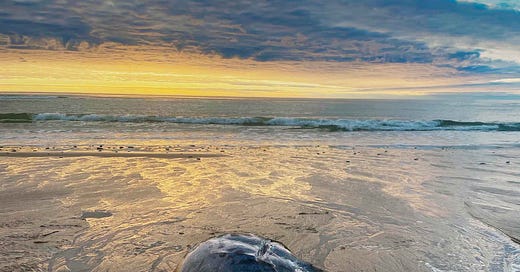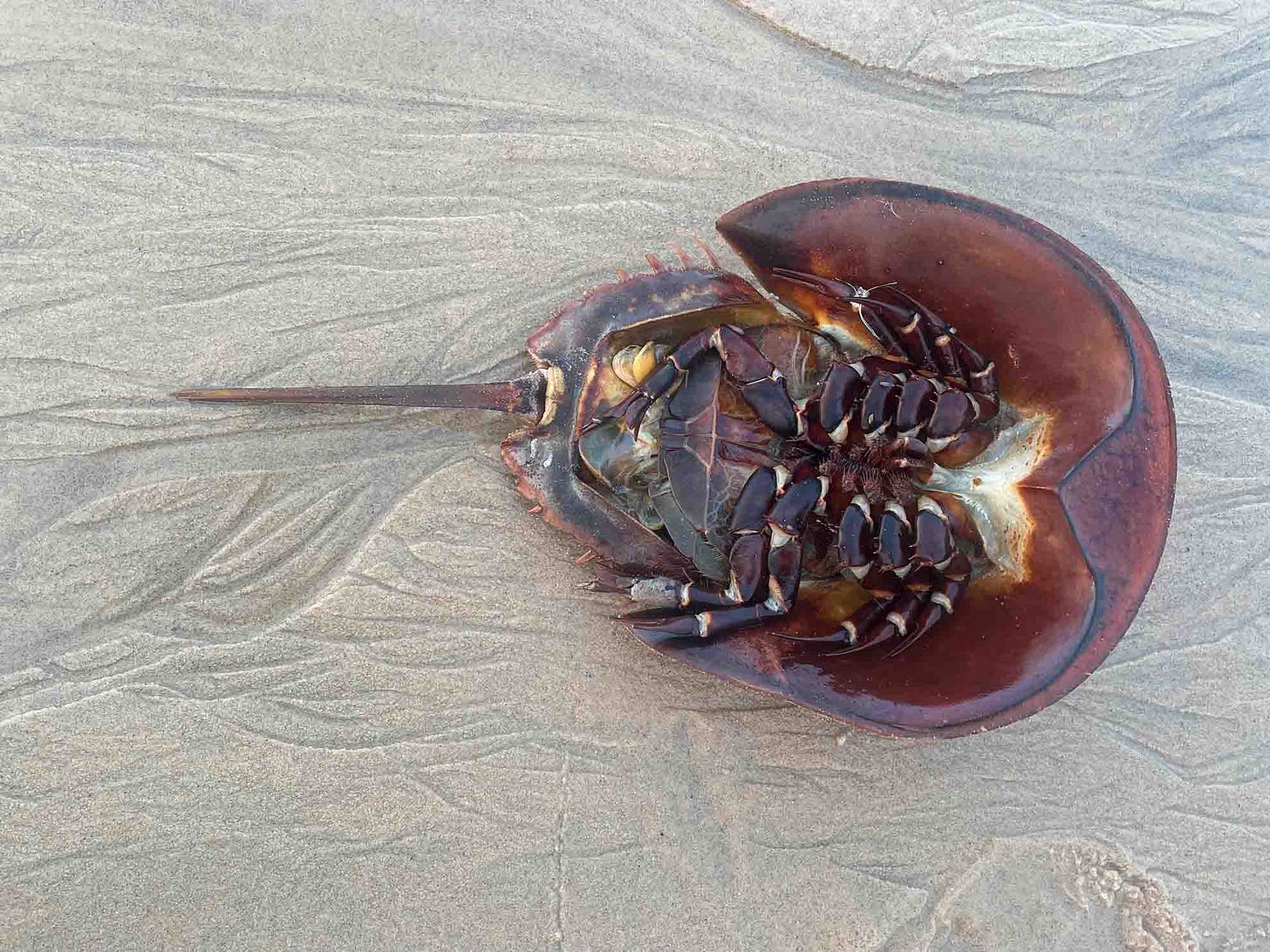This post was originally published on June 11, 2025, at AmericanGaia.Me.
—
It is 5 am on the shore of Cape Cod. Light has been flowing in for a while now, allowing me to make out the features of this landscape: Old dunes overgrown with pink beach rose, a sandy foreshore that cradles a placidly undulating sea. In the distance stroll a few other humans seeking solitude.
Sunrise
Leo stands beside me, looks for my response to this setting. Obliging, I take in the Atlantic Ocean, locate the line out east where the water meets the sky, and let my gaze be drawn to the center where gleaming magma is about to rise from a fiery puddle.
I am face to face with daybreak’s protagonist, the naked sun. As it ascends in vivid colors, it is dramatic but also forgiving: In a few hours a prolonged gaze into its brightness will leave you blinded, but right now I have permission to watch. And so I do for three minutes. That’s how quickly the sun transitions from not there to fully inhabiting the sky.
Leo, who knows the celestial motions by heart, wanted me to experience how fast we, on the Earth’s surface, are spinning eastward. The expression of awe on my face tells him that he was successful, and he smiles.
Stones
Six hours ago the water was nine feet higher than it is now, surging all the way to the dune, moving both sand and heavier items with its currents. Now that it has withdrawn into its bed, a patch of small to medium-sized stones lies exposed on the beach, as though spit out by the sea. Had I encountered these stones by the side of the road, I would not have given them a second glance. But in large congregation atop an expanse of fine sand they attract my attention. I walk over and find them resting in a shallow pool that the receding tide left behind. Wetted by the pool’s moisture, they look intensely colorful and distinctly patterned. Several stones are speckled - orange, yellow, white and gray; or white, black and pink. One looks like snowy alabaster and is so translucent that it seems to glow. Another distinguishes itself by the shallow grooves time carved into its surface. Yet another consists of clearly discernible layers of minerals that appear smashed on top of one another, yielding a tiny rocky sandwich.
I notice the smooth edges and round corners of these treasures and ponder the journeys that brought them together here and now. My knowledge of geology is slim. But I do know that often, a small pebble derives from, and therefore represents, a much larger mineral formation of its kind. This means that all these very different stones might come from vastly different geologic and geographic origins. Perhaps some were forged under heavy pressure in Newfoundland, pushed south by the Laurentide ice sheet to be washed into the ocean 100,000 years ago with glacier run-off? Might others have been present for the break-up of Africa and Northern America 200 million years ago?
Were I a geologist, I would be able to read these pieces of rock for their stories. But that is not the case, and so I creatively fabulate their journeys. It’s a second-best option. Surely the truth is far more interesting.
Horseshoe crab
Leo helps me gather up a few particularly beautiful stones, unconcerned at the weight they will add to our luggage. Then we wander on and quickly come upon an interesting collection of debris. Clam shells, including one that is punctured by a quarter-inch, perfectly crafted hole - what animal engineer was at work here? Remnants of a marine plant’s flotation bladders - might this be giant kelp? Five or six shells of rock crab.
The most interesting find is a round body armor, about eight inches in diameter, to which an armored spike of the same length is attached. The complete shell looks like a giant trilobite with tail. It turns out to be my very first sighting of a horseshoe crab, a lineage so ancient that it was in existence when Africa and North America were conjoined. Imagine that.
I marvel at the fact that this animal’s design worked 250 million years ago and in every era since, for which reason nature kept it in existence more or less unchanged. How very impressive. Later will I learn that we humans may be this animal’s doom, through overfishing and habitat destruction. But for now my gaze rests on the shell. As a member of a species that is at most 750,000 years old I feel oddly new. Like this critter I had ancestors who lived 250 million years ago, but they looked nothing like me. The experts say that our Triassic ancestor was most likely a synapsid, a reptile that would eventually give rise to mammals. Which means my ur-grandparents resembled lizards.
Of course, while the species Limulus polyphemus (Atlantic horseshoe crab) goes back far longer than Homo sapiens, the individual before me, with its five sets of limbs that appear to be pincers, lived a shorter life than I. The Internet tells me that it was female, reached maturity at nine years of age, and would have lived for a maximum of 20 years. I look at her and wonder if she made it to the end of her life expectancy. I get the feeling that we have something in common but don’t quite know what it is.
Song lines
The beach seems still, but it is in constant flux. Beneath the horseshoe crab and all around her I watch intricate lines form in the sand - filigree canyons that trace the outflow of water. The delicate striations resemble Japanese ink paintings, where the barest of brush strokes hint at entire landscapes, inviting the viewer to fill in the rest. They alert me that everything in my vicinity belongs to the ocean and will be reclaimed by it.
Before the tide turns, Leo and I leave to find breakfast. While we will go about our day, the sea will wash away everything we just saw, then spit out new items. It will be as though this morning’s encounter with stones, kelp, clam and crab had happened only in my imagination.






Your integration of science bits with personal reflections opens the lens in my mind. Thank you for that!